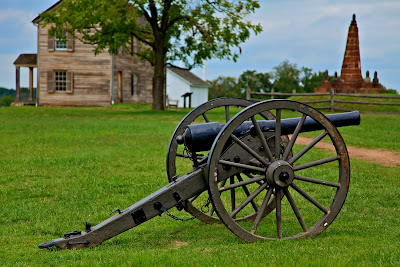- Jamestown, the first successful English settlement in America;
- Yorktown, the decisive battlefield of the Revolutionary War; and
- Williamsburg, which has been renovated into a historically-accurate theme park of the Colonial period.
This beautiful area provides a perfect setting for history geeks and photographers.
Historic Timeline
The English first tried to settle America in 1585 but the colony mysteriously disappeared within 5 years from Roanoke Island in present-day North Carolina. The second attempt in 1607 at Jamestown established a fortified settlement that struggled to become viable until the "golden weed," tobacco, became a cash crop of great value in Europe.
During the 1600's the colony gradually expanded despite setbacks that included wars with the Native American tribes in the region, and in 1699 the capital moved to the nearby town of Williamsburg.
As the capital city of the richest of the colonies, Williamsburg was the location of a number of significant events in Colonial America, including the fiery debates in the Virginia House of Burgesses that led up to the Revolution. Also, the College of William and Mary was established in 1693, the second-oldest university in America, whose famed alumni include Thomas Jefferson, James Monroe, John Marshall, and Henry Clay.
It was during the Revolutionary War that the capital was moved fifty miles inland to Richmond in 1780 because it was less vulnerable to British attack, and Williamsburg began a long slow decline.
But first it would host the camps of George Washington and French General Rochambeau as they prepared to lay siege to British General Cornwallis at Yorktown in 1781. Cornwallis had been directed to build a fortified port after a disastrous southern campaign in the Carolinas, but found himself bottled up instead when a French fleet scored a rare victory over the British to control the Chesapeake Bay.
When Cornwallis surrendered his 7,000 men on October 19th the war was effectively over.
Touring the Area
Colonial Williamsburg, restored in large part due to generous contributions from John D. Rockefeller, Jr. in the 1920's and 1930's, is the most picturesque and interesting of the three locations. The central part of town is closed to vehicular traffic and populated by re-enactors and living historians. Several buildings including the statehouse were rebuilt from the bare ground.
Though this might smack of crass modern commercialization, it actually creates a very engaging experience. The history of the buildings comes alive as the actors portray events and people of the period, and many of the historians are passionately interested in recreating authentic Colonial life (and imparting that knowledge to visitors).
The state of Virginia has created similar centers at Jamestown and Yorktown, but they are smaller (especially Yorktown) and have far less elaborate shows. These centers sit next to the historic sites which are managed by the federal park service.
The Final Word
I learned a lot over the course of two days. I would recommend that visitors focus upon Colonial Williamsburg, especially if the weather is good, spending at least a full day there and watching the outdoor street theater in the afternoon. Buses make a continual loop through the area.
The College of William and Mary is also still a functioning campus sitting immediately to the west of the Williamsburg Historic Area, and you can stroll its grounds.
Jamestowne Settlement and Yorktown Victory Center are worth half a day each and are about 20-30 minutes by car. There are free buses as well. If you have the time, you may want to visit the actual Yorktown battlefield and take a ranger-led tour, or walk through the picturesque Yorktown landing at night.
Getting There
Situated on a narrow peninsula, there are only two ways to get to Williamsburg. You can come from the direction of Richmond and travel southeast down the peninsula, or you can start from the other end by Norfolk, either coming up from North Carolina or down the Maryland Eastern Shore. I had planned to tour Norfolk as well but didn't realize it was about 45 minutes away.
I unfortunately also got caught in Friday afternoon traffic leaving the Washington, DC area, as I wasn't able to leave work before lunchtime. Though DC and Richmond are only 100 miles apart, if the Union Army had been fighting weekend traffic heading south on I-95 in addition to the Confederates, the Civil War would still be ongoing. What should have been a 3-4 hour journey to Williamsburg from Baltimore turned into an ordeal more than 6 hours long.
More Pictures
 Read the Full Post
Read the Full Post




























































